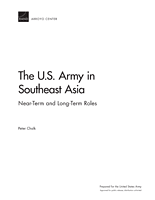 Summary
Summary
This RAND report explores the role and force posture of the U.S. Army in Southeast Asia, both now and out to 2020. The author argues that, under the current, largely benign conditions, the military will focus mainly on supporting defense reform and modernization, facilitating disaster relief response operations, providing assistance to address nonconventional transnational threats, and helping to balance China’s increased influence into the region. If the security outlook in Southeast Asia remains favorable, these mission areas will not fundamentally change over the near term. However, should the general outlook deteriorate — perhaps as a result of a severe economic slowdown — the geopolitical environment will become far less certain and more prone to crisis. Governments that have derived legitimacy from rapid development would suffer from a loss of grassroots support. State-to-state rivalries would become more acute, especially with regard to the South China Sea disputes. And natural catastrophes would take on greater security relevance because of tighter fiscal constraints for underwriting disaster preparedness and response. To meet these challenges, the United States will need to adopt an agile strategy that is thin in physical presence but broad in programmatic execution. Specifically, there are four areas in which the Army should concentrate its efforts: (1) enhancing the defense capacities of partner nations to meet both conventional and nonconventional dangers; (2) concluding new base agreements for hosting small, mission-oriented expeditionary forces; (3) expanding support for regional humanitarian assistance activities; and (4) initiating appropriate responses to counter a more outwardly adventurist China.
PDF
Chalk, Peter
Published inBlog
